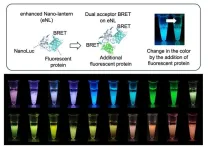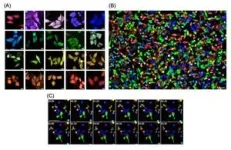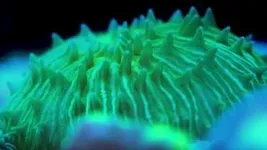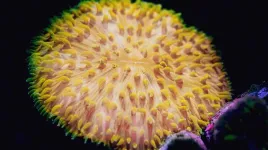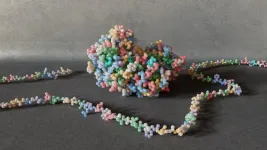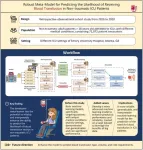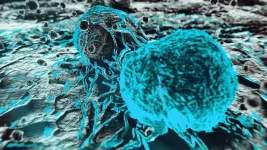(Press-News.org) Osaka, Japan – Imaging live cells with fluorescent proteins has long been a crucial technique for understanding cellular behavior. While bioluminescent proteins offer several advantages over fluorescent proteins, the limited availability of color variants has made it difficult to observe multiple targets simultaneously. Now, researchers from SANKEN (The Institute of Scientific and Industrial Research) at Osaka University have developed a groundbreaking method to expand the color palette of bioluminescent protein to 20 distinct colors, enabling advanced simultaneous multi-color imaging.
Cells are the fundamental building blocks of life. Understanding how they function is essential for progress in biological sciences, medicine, and drug discovery. Optical labeling techniques allow scientists to observe cell behavior, track cell fate, and identify cells with specific traits. While fluorescent proteins are widely used for these purposes, bioluminescent proteins are gaining popularity due to their unique advantages.
Bioluminescence, the natural emission of light by living organisms, is powered by a chemical reaction catalyzed by an enzyme, typically a luciferase, acting on a bioluminescent substrate. Unlike fluorescent proteins, bioluminescent proteins do not require external light for excitation, avoiding issues like phototoxicity and background light. However, their use has been limited by the small number of available colors. Having distinct and easily distinguishable colors is vital tracking multiple targets simultaneously.
Previously, a five-color series of bioluminescent labels was created by coupling one of the brightest luciferases, NanoLuc, with a fluorescent protein. This technique leverages the transfer of excited-state energy from the substrate to the fluorescent protein, altering the bioluminescence color. While effective, this five-color palette was insufficient for more complex imaging needs. The researchers at Osaka University have now addressed this challenge by expanding the bioluminescent color palette to 20, making a significant leap forward in multi-color imaging technology.
“Instead of fusing NanoLuc with single fluorescent protein, we fused it with two,” says lead author Mitsuru Hattori. “This approach allowed us to access a much broader range of bioluminescence colors by fine-tuning the combinations of fluorescent proteins.”
The researchers achieved remarkable milestone with their new bioluminescent protein labels. They captured a single-shot image of a mixture of cells expressing all 20 bioluminescent proteins, used the labels to visualize distinct subcellular components, and even demonstrated their capability in live mice. Additionally, they successfully conducted time-lapse observations of cell behavior over several hours, simultaneously tracking seven distinct labels.
“What’s truly exciting is that we could detect all 20 colors simultaneously without any time lag, using a standard smartphone camera,” explains senior author Takeharu Nagai. “This innovation makes it significantly easier and more cost-effective to monitor multiple targets or track individual cells within a population.”
These newly developed bioluminescent colors have the potential to revolutionize cell fate tracking, offering insights concerning how cells develop into specific cell types and identifying cells with unique responses to drugs. The team’s breakthrough in bioluminescent imaging opens new doors for advancements in biological research, drug discovery, and medical science. With such a vivid “rainbow” of bioluminescent colors, who knows what scientific treasures lie ahead?
###
The article, “Creating coveted bioluminescence colors for simultaneous multi-color bioimaging,” was published in Science Advances at DOI: https://doi.org/10.1126/sciadv.adp4750
About Osaka University
Osaka University was founded in 1931 as one of the seven imperial universities of Japan and is now one of Japan's leading comprehensive universities with a broad disciplinary spectrum. This strength is coupled with a singular drive for innovation that extends throughout the scientific process, from fundamental research to the creation of applied technology with positive economic impacts. Its commitment to innovation has been recognized in Japan and around the world. Now, Osaka University is leveraging its role as a Designated National University Corporation selected by the Ministry of Education, Culture, Sports, Science and Technology to contribute to innovation for human welfare, sustainable development of society, and social transformation.
Website: https://resou.osaka-u.ac.jp/en
END
Bioluminescent cell imaging gets a glow-up
Researchers from Osaka University develop a method to increase the number of bioluminescence colors for cell imaging, making it easier to track many targets simultaneously
2025-01-22
ELSE PRESS RELEASES FROM THIS DATE:
Float like a jellyfish: New coral mobility mechanisms uncovered
2025-01-22
When it comes time to migrate, QUT research has found how a free-living coral ignores the classic advice and goes straight towards the light.
The research – led by Dr Brett Lewis from the QUT School of Atmospheric and Earth Sciences and Reef Restoration and Adaptation Program, and published in PLOS One – investigated how the free-living mushroom coral Cycloseris cyclolites moves, navigates and responds to light in its natural environments.
“Not all corals are attached to the substrate; some are solitary and free-living, allowing them to migrate into preferred habitats,” ...
Severe weather and major power outages increasingly coincide across the U.S.
2025-01-22
An understanding of the relationship between severe weather and power outages in our changing climate will be critical for hazard response plans, according to a study led by a researcher at Columbia University Mailman School of Public Health. The study is published in the open-access journal PLOS Climate.
Throughout the U.S., large-scale power outages commonly occur alongside severe weather events. These combined events can be associated with major economic costs and health risks, as loss of power can disrupt medical equipment, heating or air conditioning, and other important systems. As severe weather events increase in severity and frequency ...
Who to vaccinate first? Penn engineers answer a life-or-death question with network theory
2025-01-22
Engineering and medical researchers at Penn have developed a groundbreaking framework that can determine the best and most computationally optimized distribution strategy for COVID-19 vaccinations in any given community. Published in PLOS One, this study addresses one of the most critical challenges in pandemic response — how to prioritize vaccination efforts in communities with individuals of different risk levels when supplies are scarce and the stakes are high.
The research team, comprised of Saswati Sarkar, Professor ...
Research shows PTSD, anxiety may affect reproductive health of women firefighters
2025-01-22
TUCSON, Arizona — A new study led by University of Arizona Mel and Enid Zuckerman College of Public Health researchers in collaboration with fire service partners and other researchers around the country through the Fire Fighter Cancer Cohort Study showed that post-traumatic stress disorder and anxiety are associated with lower levels of anti-Müllerian hormone, a marker of ovarian reserve, among women firefighters.
The ovarian reserve is the number of healthy eggs in a woman’s ovaries that ...
U of M Medical School research team receives $1.2M grant to study Tourette syndrome treatment
2025-01-22
MINNEAPOLIS/ST. PAUL (1/22/2025) — A research team from the University of Minnesota Medical School recently received a three-year, $1.2 million grant from the National Institutes of Health to study the use of transcranial magnetic stimulation (TMS) as a treatment for youth with Tourette syndrome and other tic disorders.
These conditions affect one in every 50 children and are characterized by involuntary movements or sounds called “tics.” Tics are often painful, distressing and interfere with daily life activities. In some cases, tics can be quite disabling.
The research team recently completed the first phase of this clinical trial ...
In the hunt for new and better enzymes, AI steps to the fore
2025-01-22
Enzymes are crucial to life. They are nature’s little catalysts. In the gut, they help us digest food. They can enhance perfumes or get laundry cleaner with less energy. Enzymes also make potent drugs to treat disease. Scientists naturally are eager to create new enzymes. They imagine them doing everything from drawing greenhouse gases out of the skies to degrading harmful toxins in the environment.
That age-old quest for new enzymes just got a whole lot easier. A team of bioengineers and synthetic biologists has developed a computational workflow that can design thousands of new enzymes, predict how they will behave in the real world, and test their performance ...
Females have a 31% higher associated risk of developing long COVID, UT Health San Antonio-led RECOVER study shows
2025-01-22
SAN ANTONIO, Jan. 22, 2025 – Females have a 31% higher associated risk of developing long COVID, with women aged 40 to 55 years having the highest propensity, according to a study led by The University of Texas Health Science Center at San Antonio (UT Health San Antonio) funded by the National Institutes of Health.
The findings are part of a nationwide initiative launched by NIH, called Researching COVID to Enhance Recovery, or RECOVER, to understand the long-term health effects of COVID-19.
The latest ...
Final synthetic yeast chromosome unlocks new era in biotechnology
2025-01-22
Macquarie University researchers have worked with an international team of scientists to achieve a major milestone in synthetic biology by completing the creation of the final chromosome in the world's first synthetic yeast genome.
This achievement represents the completion of the global Sc2.0 project to create the world's first synthetic eukaryotic genome from Saccharomyces cerevisiae (baker's yeast) and a new-to-nature tRNA neochromosome.
Using cutting-edge genome-editing techniques, including the CRISPR D-BUGS protocol, the team identified and corrected genetic errors that impacted yeast growth. These changes restored the strain’s ability to grow on glycerol, ...
AI-powered prediction model enhances blood transfusion decision-making in ICU patients
2025-01-22
Researchers at Emory University have developed a groundbreaking artificial intelligence (AI) model capable of accurately predicting the likelihood of blood transfusion in non-traumatic intensive care unit (ICU) patients. Published in Health Data Science, the study addresses longstanding challenges in predicting transfusion needs across diverse patient groups with varying medical conditions.
Blood transfusions are critical in managing anemia and coagulopathy in ICU settings, yet current clinical decision support systems often ...
MD Anderson Research Highlights for January 22, 2025
2025-01-22
HOUSTON ― The University of Texas MD Anderson Cancer Center’s Research Highlights showcases the latest breakthroughs in cancer care, research and prevention. These advances are made possible through seamless collaboration between MD Anderson’s world-leading clinicians and scientists, bringing discoveries from the lab to the clinic and back.
Novel allogeneic NK cell therapy from induced pluripotent stem cells shows encouraging efficacy in relapsed or refractory B-cell lymphoma patients
Patients ...
LAST 30 PRESS RELEASES:
Electrodes created using light
Second-hand gift-giving is a well-deliberated decision
How human interaction drove evolution to make bears less aggressive
National Poll: Few parents offer teens guidance on healthy eating during holiday season
Cannabis derivatives could provide new ovarian cancer treatments
Raising strong yeast as a petroleum substitute
Clues to the origin of hot Jupiters hidden in their orbits
Canada’s reduced pledge to Global Fund will impact domestic health
1 in 4 children with major traumatic injuries not cared for in pediatric trauma centres
Duke and Duke-NUS’ joint cross-population research to uncover "East-West" differences in disease and care
Scientists to ‘spy’ on cancer- immune cell interactions using quantum technology breakthrough
Tech savvy users have most digital concerns
Making lighter work of calculating fluid and heat flow
Normalizing blood sugar can halve heart attack risk
Lowering blood sugar cuts heart attack risk in people with prediabetes
Study links genetic variants to risk of blinding eye disease in premature infants
Non-opioid ‘pain sponge’ therapy halts cartilage degeneration and relieves chronic pain
AI can pick up cultural values by mimicking how kids learn
China’s ecological redlines offer fast track to 30 x 30 global conservation goal
Invisible indoor threats: emerging household contaminants and their growing risks to human health
Adding antibody treatment to chemo boosts outcomes for children with rare cancer
Germline pathogenic variants among women without a history of breast cancer
Tanning beds triple melanoma risk, potentially causing broad DNA damage
Unique bond identified as key to viral infection speed
Indoor tanning makes youthful skin much older on a genetic level
Mouse model sheds new light on the causes and potential solutions to human GI problems linked to muscular dystrophy
The Journal of Nuclear Medicine ahead-of-print tip sheet: December 12, 2025
Smarter tools for peering into the microscopic world
Applications open for funding to conduct research in the Kinsey Institute archives
Global measure underestimates the severity of food insecurity
[Press-News.org] Bioluminescent cell imaging gets a glow-upResearchers from Osaka University develop a method to increase the number of bioluminescence colors for cell imaging, making it easier to track many targets simultaneously
